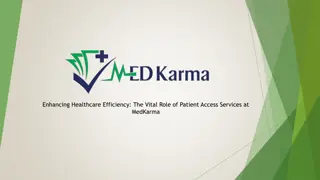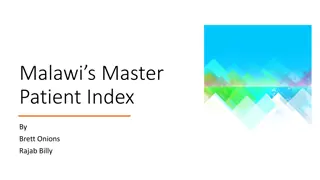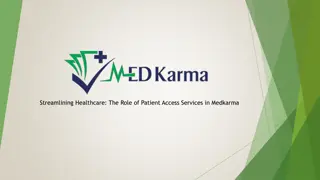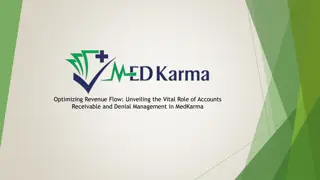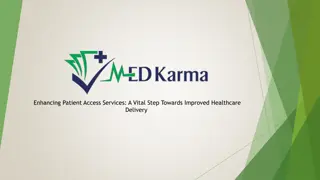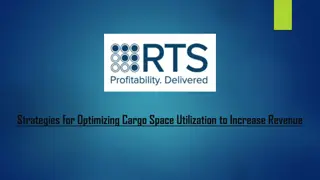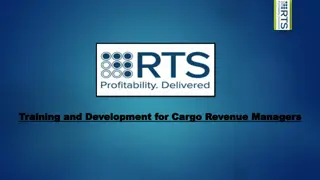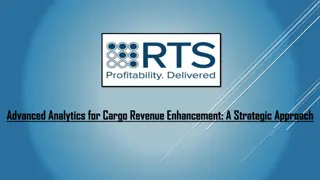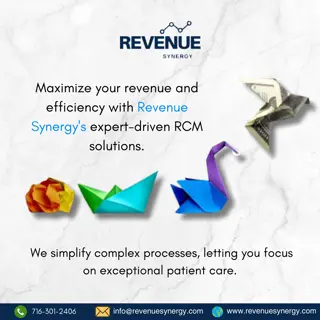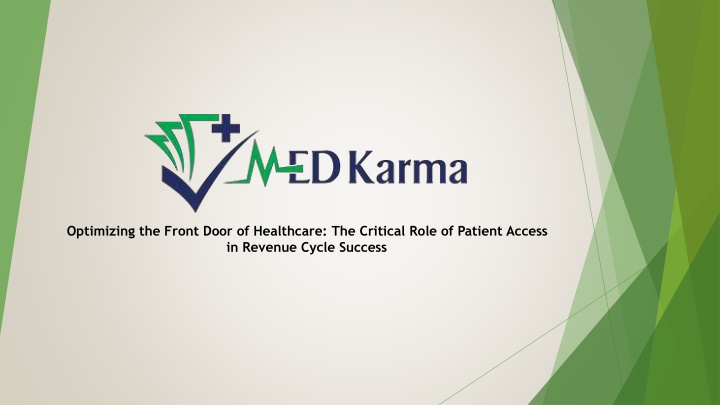
Optimizing the Front Door of Healthcare, The Critical Role of Patient Access in Revenue Cycle Success (2)
The cornerstone of a thriving healthcare practice lies not just in the quality of clinical care provided but also in the efficiency of its revenue cycle management (RCM). At the heart of RCM is patient accessu2014a critical phase that encompasses all the processes involved in ensuring a patientu2019s entry into the healthcare system is smooth, from scheduling and registration to insurance verification and pre-authorization.
Download Presentation

Please find below an Image/Link to download the presentation.
The content on the website is provided AS IS for your information and personal use only. It may not be sold, licensed, or shared on other websites without obtaining consent from the author. If you encounter any issues during the download, it is possible that the publisher has removed the file from their server.
You are allowed to download the files provided on this website for personal or commercial use, subject to the condition that they are used lawfully. All files are the property of their respective owners.
The content on the website is provided AS IS for your information and personal use only. It may not be sold, licensed, or shared on other websites without obtaining consent from the author.
E N D
Presentation Transcript
Optimizing the Front Door of Healthcare: The Critical Role of Patient Access in Revenue Cycle Success
The cornerstone of a thriving healthcare practice lies not just in the quality of clinical care provided but also in the efficiency of its revenue cycle management (RCM). At the heart of RCM is patient access a critical phase that encompasses all the processes involved in ensuring a patient s entry into the healthcare system is smooth, from scheduling and registration to insurance verification and pre-authorization. This blog delves into the significance of patient access and how it lays the groundwork for successful revenue cycle management.
Patient Access: The Gateway to Financial Health Patient access services are the first interaction point between the patient and the healthcare provider. This stage sets the tone for the patient s experience and plays a pivotal role in securing the financial viability of healthcare practices. Effective management of patient access processes can lead to improved patient satisfaction, higher collection rates, and reduced claim denials.
Key Components of Patient Access Scheduling and Registration: Efficient scheduling systems and thorough registration processes ensure that patient information is accurate and complete. This reduces billing errors and denials due to incorrect patient data. Eligibility and Insurance Verification: Verifying insurance eligibility and benefits before services are rendered is crucial. It helps identify coverage limits, copayments, and deductibles, facilitating accurate patient billing and minimizing denials.
Strategies for Optimizing Patient Access Invest in Training: Regular training for staff involved in patient access roles is essential. This ensures they are up-to-date with the latest insurance regulations, billing practices, and customer service standards. Leverage Technology: Implementing advanced scheduling and registration systems, along with electronic verification tools, can streamline patient access processes, reduce errors, and save time. Enhance Communication: Clear and open communication with patients regarding their appointments, financial responsibilities, and any required documentation can prevent delays and improve patient engagement.
Conclusion Patient access is more than just the first step in the patient s journey through the healthcare system; it s a critical determinant of a practice s financial health and operational efficiency. By prioritizing and optimizing patient access processes, healthcare providers can build a strong foundation for successful revenue cycle management. This ensures financial sustainability and enhances the patient experience, reinforcing the value of quality care and service excellence in healthcare. Tags : patient access services,Patient Contact Solutions,revenue cycle management



